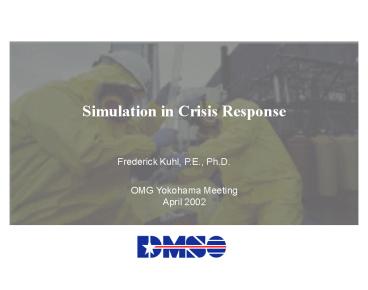Simulation in Crisis Response - PowerPoint PPT Presentation
1 / 12
Title:
Simulation in Crisis Response
Description:
Simulation Is Used Widely in Civil and Military Preparations for Crisis Response ... E.g., Science Applications International Corporation, http://www.saic.com ... – PowerPoint PPT presentation
Number of Views:66
Avg rating:3.0/5.0
Title: Simulation in Crisis Response
1
Simulation in Crisis Response
Frederick Kuhl, P.E., Ph.D.
OMG Yokohama MeetingApril 2002
MITRE
2
Simulation Is Used Widely in Civil and Military
Preparations for Crisis Response
- Computer-based simulation and modeling is used by
civil and military organizations to prepare for
crisis response - Uses of simulation fall into several categories
- Training of individuals and small groups
- Training of large groups or staffs
- Analysis and prediction of consequences of crises
3
In Civilian Crisis Response, Simulation Usually
Means Role-Playing
- Simulation of a crisis involves many people
playing a variety of roles - emergency medical technicians
- chemical technicians
- government authorities and police
- injured or ill persons
- Usual goals are to test and rehearse procedures
- Such simulations are conducted by
- Local and federal governments
- Hospitals and schools
- Computer simulation is used alongside
role-playing to change the exercise script as
simulation progresses
4
Computer Simulation to Train Local Officials
- Role playing involves many people and trains many
people - Computer simulation is more widespread in
training individuals - Hazardous materials incident
- Simulation runs on personal computer video,
audio, computer graphics - E.g., International Association of Emergency
Managers, http//www.iaem.com/body_fema_hazmat_sim
ulation.html
5
Distributed Simulation Not Widespread in Civil
Crisis Response
- Military uses distributed simulation for training
- Often conducts command post exercises to train
military staffs - Training audience often geographically dispersed
- Training simulation often combines diverse
computer models, e.g., air, land, sea warfare - OMG technologies used for distributed simulation
- Distributed simulation not widespread in civil
use - Technically feasible
- Perhaps civil training audience less dispersed
geographically - There may not exist as many civil computer models
to be combined
6
Civil Simulation for Analysis Quite Common
- Simulation used to predict consequences of
- Accidents at chemical or nuclear facilities
- Nuclear, biological or blast weapons of mass
destruction - Hurricanes or earthquakes
- E.g., Science Applications International
Corporation,http//www.saic.com/natsec/model.htm
l
7
Transportation Security Administration Prepares
to Use Simulation
- TSA organized after attacks on September 11
- TSA is responsible for security of all
transportation in the U.S. immediate concern is
civil air transportation - TSA is organizing research efforts in
- Analysis of passenger and baggage screening in
airports - Architecture of information systems to support
passenger screening - Training of security personnel on aircraft
- Training of command center staffs
8
U.S. Military NATO Execute Operations Other
Than War (OOTW)
- Examples of OOTW
- Civil affairs and psychological operations
- Peace-keeping
- Humanitarian and disaster-relief operations
- OOTW combine and blur distinction between
military operations and civil government - Use of simulation in OOTW falls into same
categories as in civil crisis response - individual and small-unit training
- staff training in larger exercises
- analysis and prediction
9
U.S. Army Exploring Use of Entertainment
Technology for Individual Training
- Institute for Creative Technologies, Univ.
Southern California, has contract to apply
entertainment and game technologies to immersive
training
- Individual or small group immersed in realistic
video and sound using film and game techniques - Subjects are required to make decisions in real
time under pressure - Scenarios often from OOTW or interactions with
civil population - See http//www.ict.usc.edu/
10
Staff Training in OOTW Deployable Exercise System
- Training support system for staff exercises
- Models objects and environment suitable for OOTW
scenarios - System being moved to distributed platform
chiefly to incorporate other simulations
11
Where Standards Can Play a Role
- Standards become more important as the degree of
coupling between simulations increases - Typical standalone training simulation requires
no coupling - Coordination of analytical results requires
common data models, including geospatial
information - Federation of simulations requires common data
models and technical infrastructure - Technical problems between nations the same as
within - Common data models for civil crisis planning do
not exist military OOTW models could be starting
point - Common environment models exist, E.g., SEDRIS,
GIS standards - Simulation interoperability standards High Level
Architecture for MS, an OMG standard
12
Summary
- Simulation is in wide use in crisis response,
both civil and military - Use of simulation follows usual pattern
- Analysis
- Individual training
- Staff training
- Crisis response is unusual in large-scale
simulation by role-playing - OMG technologies for distributed simulation are
used in the military not used much in civil
applications thus far

